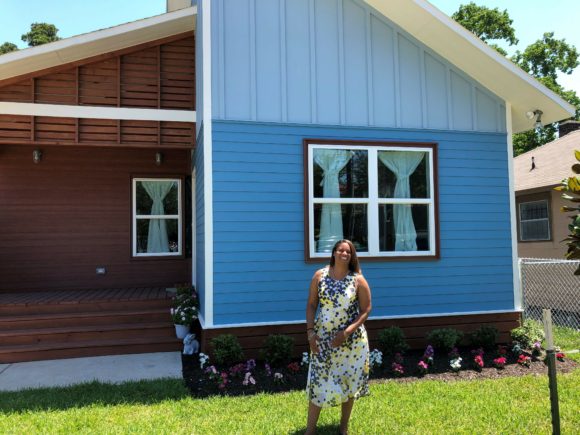HOUSTON — For Houston resident Scenacia Jones, the experience of getting her new home through an innovative way of building post-disaster housing was like an experiment.
Jones and her two children had been living in a shelter for single parents when Hurricane Harvey’s devasting flooding hit the Houston area in August 2017. All the family’s possessions were lost after the storage facility they were in flooded.
Desperately looking for a permanent place to live, Jones was approached by organizations behind the housing program known as Rapido, Spanish for fast. Under the program, a temporary modular core unit made up of interlocking wall, roof and floor panels would be built. Jones, her 10-year-old son Nyjel, who is disabled, and 12-year-old daughter Nnaji would live there while the rest of the house was built around them. The core is about the size of a Federal Emergency Management Agency trailer. The process took about eight months, and Jones and her children now have a new, three-bedroom home, which looks like any other house.
“It has definitely been an experiment. We tried to keep a positive attitude because at the end of this experiment, we get to live in this beautiful house,” Jones said this week as she gave a tour of her home, the first such Rapido house built in Houston.
The 1,200 to 1,300-square-foot home with a front yard has three bedrooms, a ramp in the front for her son’s wheelchair and a bathroom designed to be handicapped-accessible. Jones’ home, which was built on an empty lot, looks like a newer version of the other bungalow-style homes in the neighborhood.
The groups behind the Rapido program say their approach will save money and get people into housing more quickly. They’re hopeful a bill signed this week by Texas Gov. Greg Abbott related to disaster planning will be a boost to their efforts.
The Texas General Land Office, in charge of short-term housing recovery efforts in the state after Harvey , says the agency strongly backs new housing innovations like Rapido but rule changes would need to occur to free up federal funding to support such ideas.
John Henneberger, co-director of Texas Housers, an Austin-based nonprofit that’s one of the groups behind the Rapido program, said funding would be better spent on their program as opposed to FEMA trailers or hotel vouchers, which are typically used to temporarily house people after a disaster. Each Rapido home costs about of $145,000 to $150,000, while a FEMA trailer can cost up to $100,000 to buy and set up, Henneberger said. At some point, trailers are taken away and the hotel vouchers end, he said.
“If we can build more houses with the same amount of money, it just means more families get a home,” Henneberger said. “It’s a win-win.”
The Rapido program, first brainstormed nearly 15 years ago, has built 20 homes in South Texas and three in the Southeast Texas city of Port Arthur. The homes can be built on empty lots that are either owned by the nonprofits involved in the program or land owned by local governments. They can also be built on the site of a damaged home that has been razed or even partially built to provide shelter while a damaged home is fixed.
With the completion of the Houston home, Henneberger said the hope is the program can be used on a larger scale with funding from local, state and federal governments.
The groups behind Rapido are hopeful a new state law allowing local governments the ability to develop and adopt disaster recovery plans before a storm, including procedures detailing housing rebuilding efforts, will help their endeavor. Henneberger would like local governments as well as the state to consider incorporating Rapido in their disaster plans.
Brittany Eck, a spokeswoman for the Texas General Land Office, said Land Commissioner George P. Bush has spoken in favor of rapid housing alternatives in the wake of Harvey.
But for such innovative, permanent housing ideas to be able to utilize federal funding, rules would have to be changed allowing temporary housing funds to be used, Eck said. The housing funds that FEMA provides right after a storm are for temporary housing like hotels and trailers. The funding for permanent housing comes from U.S. Department of Housing and Urban Development grants, which can take years to be disbursed.
Bush said he is working with federal lawmakers on trying to change the rules and combine both pots of money.
Jones said she’s grateful she no longer worries about where she’s going to live and can focus on her children, including her son, who has a rare chromosomal disorder that makes him totally dependent on others for care.
“We can breathe easy and be able to live the American dream,” Jones said.
About the photo: Houston resident Scenacia Jones, stands in front of her new home, part of an innovative program that builds houses after natural disasters and lets families live in one part of the structure while the rest is completed. (AP Photo/Juan Lozano)
Was this article valuable?
Here are more articles you may enjoy.


 FAA Must Do Better After Midair Collision, Acting Chief Says
FAA Must Do Better After Midair Collision, Acting Chief Says  Novogratz’s Galaxy to Pay $200 Million in NY Luna Settlement
Novogratz’s Galaxy to Pay $200 Million in NY Luna Settlement  What Claims Pros Must Know About Small Businesses’ Insurance Blind Spots
What Claims Pros Must Know About Small Businesses’ Insurance Blind Spots  Catastrophe Experts Tap AI to Tackle Soaring Insured Losses
Catastrophe Experts Tap AI to Tackle Soaring Insured Losses 